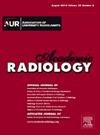热消融治疗 I 期非小细胞肺癌患者的有效性和安全性
IF 3.8
2区 医学
Q1 RADIOLOGY, NUCLEAR MEDICINE & MEDICAL IMAGING
引用次数: 0
摘要
依据和目的:本研究旨在衡量热消融(包括射频消融(RFA)和微波消融(MWA))对I期非小细胞肺癌(NSCLC)患者的安全性和有效性:检索从开始到 2023 年 11 月的 PubMed 数据库,以确定相关研究。统计分析使用 R 3.6.3.结果最终纳入了 33 项研究,涉及 1400 名患者。根据我们的研究,60 岁以上的 I 期 NSCLC 患者的发病率为 98 %(95 % CI [94-100%]);病变主要位于 RUL(右上叶)和 LUL(左上叶),两个部位的发病率分别为 29 %(95 % CI [23-35%])和 27 %(95 % CI [21-33%]);肺癌类型主要包括腺癌、鳞癌和大细胞肺癌,其中腺癌所占比例最大,为63%(95% CI [56-70%]);死亡原因主要分为癌症相关(57%,95%CI [40-74%])和非癌症相关(40%,95%CI [23-58%]);术后常见并发症为气胸和疼痛,发生率分别为33%(95%CI[24-44%])和33%(95%CI[19-50%]),MWA术后并发症发生率略高于RFA;局部复发率为23%(95%CI[17-29%]),远处复发率为18%(95%CI[7-32%]);汇总结果显示,1 年、2 年、3 年和 5 年生存率分别为 96%、81%、68% 和 42%,1 年、2 年、3 年和 5 年癌症特异性生存率(CSS)分别为 98%、88%、75% 和 58%,1 年、2 年、3 年和 5 年无病生存率(DFS)分别为 87%、63%、57% 和 42%,RFA 组与 MWA 组在生存率、CSS 和 DFS 方面无显著差异。结论消融治疗对 I 期 NSCLC 患者安全有效。MWA和RFA的疗效、安全性和预后相当,可推荐用于Ⅰ期NSCLC患者,尤其是不能耐受开放手术的患者。本文章由计算机程序翻译,如有差异,请以英文原文为准。
Efficacy and Safety of Thermal Ablation for Patients With Stage I Non-small Cell Lung Cancer
Rationale and Objectives
The objective of this study was to measure the safety and efficacy of thermal ablation, including radiofrequency ablation (RFA) and microwave ablation (MWA), for patients with stage I non-small cell lung cancer (NSCLC).
Materials and Methods
The databases PubMed was searched from inception to November 2023 to identify relevant studies. Statistical analyses were performed with R version 3. 6. 3.
Results
Thirty-three studies involving 1400 patients were finally included. According to our study, the incidence of patients with stage I NSCLC who were older than 60 years old was 98 % (95 % CI [94–100 %]); the lesions were mostly located in RUL (Right Upper Lobe) and LUL (Left Upper Lobe), and the incidence of the two sites was 29 % (95 % CI [23–35 %]) and 27 % (95 % CI [21–33 %]), respectively; the types of lung cancers mainly included adenocarcinoma, squamous carcinoma, and large-cell lung cancer, of which adenocarcinoma accounted for the largest proportion of 63 % (95 % CI [56–70 %]); the causes of death were mainly categorized into cancer-related (57 %, 95 %CI[40–74 %]) and noncancer-related (40 %, 95 %CI [23–58 %]); the common complications in the postoperative period were pneumothorax and pain, with the incidence of 33 % (95 %CI[24–44 %]) and 33 % (95 %CI[19–50 %]), and the rate of the postoperative complications in MWA was slightly higher than those in RFA; the local recurrence rate was 23 % (95 %CI[17–29 %]) and the distant recurrence rate was 18 % (95 %CI[7–32 %]); the pooling result showed the rate of 1-, 2-, 3-, and 5-year survival rate were 96 %, 81 %, 68 %, and 42 %, the Cancer-specific survival (CSS) rates at 1, 2, 3, and 5 years were 98 %, 88 %, 75 %, and 58 %, Disease-free survival (DFS) rates at 1, 2, 3, and 5 years were 87 %, 63 %, 57 %, and 42 %, there were no significant differences existed between the RFA group and MWA group in survival rate, CSS and DFS.
Conclusion
Ablation therapy is safe and effective for stage I NSCLC patient. MWA and RFA have comparable efficacy, safety, and prognosis, which could be recommended for patients with stageⅠNSCLC, especially for patients who cannot tolerate open surgery.
求助全文
通过发布文献求助,成功后即可免费获取论文全文。
去求助
来源期刊

Academic Radiology
医学-核医学
CiteScore
7.60
自引率
10.40%
发文量
432
审稿时长
18 days
期刊介绍:
Academic Radiology publishes original reports of clinical and laboratory investigations in diagnostic imaging, the diagnostic use of radioactive isotopes, computed tomography, positron emission tomography, magnetic resonance imaging, ultrasound, digital subtraction angiography, image-guided interventions and related techniques. It also includes brief technical reports describing original observations, techniques, and instrumental developments; state-of-the-art reports on clinical issues, new technology and other topics of current medical importance; meta-analyses; scientific studies and opinions on radiologic education; and letters to the Editor.
 求助内容:
求助内容: 应助结果提醒方式:
应助结果提醒方式:


